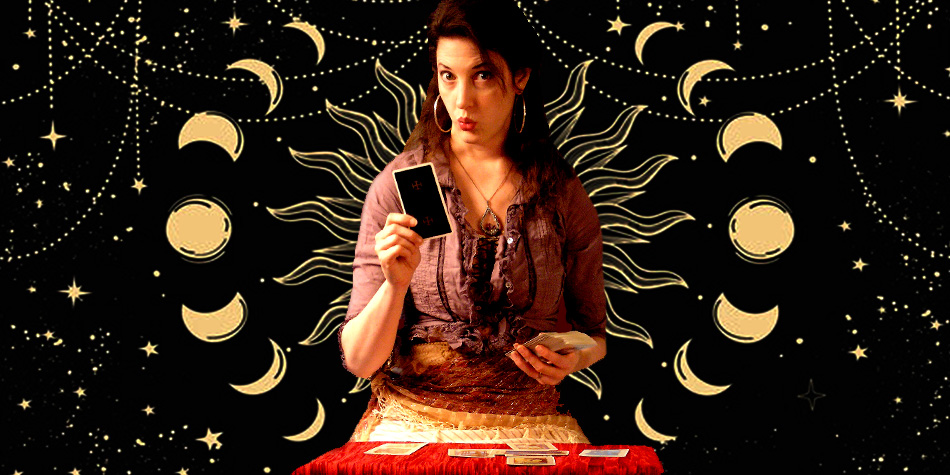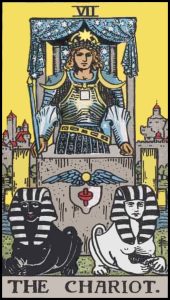
By Katrina Rasbold
In the classic Rider–Waite–Smith Tarot deck, illustrated by Pamela Colman Smith and published in 1909 under the direction of Arthur Edward Waite, The Chariot stands tall as the seventh Major Arcana card. Numbered VII and embodying themes of victory, self-mastery, and willpower, this iconic card captures the moment when determination and divine alignment fuse into forward momentum.
Let us explore the many layers of symbolism in Smith’s artwork and unpack how this complex image translates into powerful interpretive meanings for readers today.
Visual Symbolism in The Chariot
Pamela Colman Smith’s illustration of The Chariot card is rich with esoteric and mythological allusions, drawing from the traditions of Kabbalah, alchemy, astrology, and ceremonial magic. Each visual element contributes to the card’s overarching message of triumphant progress through discipline and alignment of opposing forces.
The Charioteer
 At the center of the card stands a solemn, armored figure in a chariot. His calm expression and still posture contrast with the dynamic symbolism surrounding him. He wears a crown topped with a star, alluding to spiritual guidance and celestial influence. This crown marks him not just as a warrior but as a noble or priest of sorts—one who leads through inner wisdom and divine order, not brute strength alone.
At the center of the card stands a solemn, armored figure in a chariot. His calm expression and still posture contrast with the dynamic symbolism surrounding him. He wears a crown topped with a star, alluding to spiritual guidance and celestial influence. This crown marks him not just as a warrior but as a noble or priest of sorts—one who leads through inner wisdom and divine order, not brute strength alone.
His armor is decorated with alchemical and celestial symbols, including crescent moons on his shoulders (echoing the divine feminine and intuition) and a square on his chest (symbolizing earth, structure, and the material world). This suggests a mastery of both spiritual and earthly realms.
Notably, the charioteer holds no reins. His control over the vehicle is not physical but mental and spiritual—he is guiding the chariot through sheer willpower, intention, and balance.
The Sphinxes
Instead of traditional horses, the Chariot is drawn by two sphinxes—one black, one white—positioned in repose. These mythical creatures symbolize opposing forces: light and dark, conscious and unconscious, masculine and feminine, will and instinct. They represent the polarities we all must navigate and balance to move forward effectively.
That they are seated yet the chariot is a card of movement underscores the card’s deeper teaching: control comes not from external motion, but from internal mastery.
The Canopy of Stars
Over the charioteer is a canopy decorated with stars, reinforcing the connection between the earthly journey and the celestial realm. This symbolizes divine protection, the cosmic order, and the guidance of fate or destiny. It reflects the Hermetic principle of “as above, so below,” implying that alignment with higher truths leads to success in the material world.
The City Behind
In the background, a wall or city lies behind the chariot, marking the transition from the safety of civilization into the unknown. The charioteer has left behind the structures of society and is moving forward on a spiritual and personal journey. This resonates with the hero’s journey archetype—the moment of departure when the individual leaves behind the familiar to pursue higher goals.
Numerology: The Power of Seven
The Chariot is card VII in the Major Arcana. The number seven is deeply spiritual, associated with initiation, introspection, and sacred knowledge. It appears frequently in religious and mystical contexts: the seven chakras, seven classical planets, seven days of the week.
In Tarot, seven often denotes challenges and choices that require internal strength and moral clarity. The Chariot, as VII, represents the moment when the spiritual seeker integrates conflicting forces and prepares to ascend.
Interpretation in Readings
Upright Keywords:
- Victory
- Determination
- Self-discipline
- Willpower
- Control
- Movement and travel
- Triumph over adversity
Interpretive Themes (Upright):
- Triumph Through Control:
When this card appears upright, it often heralds success, but only through focus and discipline. It reminds the querent that while the road ahead may be challenging, they have the inner strength and tools to prevail—if they maintain focus and harness their dualities. - Harnessing Opposites:
The black and white sphinxes invite the reader to ask: What opposing forces in your life need to be brought into alignment? This card encourages unity between action and intention, intuition and reason, desire and responsibility. - Movement and Purpose:
The Chariot can also signify literal or metaphorical movement: relocation, career advancement, or setting off on a purposeful journey. It speaks to motion with direction, as opposed to wandering. - Mental Mastery Over Emotion:
The calm demeanor of the charioteer amid symbolic forces suggests rational control over emotional turbulence. The card advocates for cool-headedness and strategic thinking in the face of obstacles.
Reversed Interpretation
Reversed Keywords:
- Lack of direction
- Defeat
- Scattered energy
- Aggression or forcefulness
- Being stuck
- Misalignment
Interpretive Themes (Reversed):
- Loss of Control:
Reversed, The Chariot may indicate that the querent is being pulled in opposite directions, lacking clarity or control. It can point to internal conflict or indecision that impedes progress. - Forcing Outcomes:
This reversal can warn against overly aggressive behavior, where the querent tries to push ahead by force without inner alignment. It advises checking one’s motives and whether actions are aligned with true values. - Blocked Movement:
Stagnation, travel delays, or failed endeavors may be on the horizon. Rather than trying to bulldoze through the blockage, the card suggests returning to inner balance. - Reclaiming Focus:
The Chariot reversed can serve as a call to refocus—both on one’s goals and the methods used to achieve them. It may be time to step back and align inner desires before resuming forward motion.
Mythological and Esoteric Connections
- Solar Chariots: In myth, chariots often carry gods across the sky—Apollo’s sun chariot, for instance—representing cosmic order and power. The Chariot card carries echoes of these divine journeys.
- Merkabah Mysticism: In Kabbalistic tradition, the “Merkabah” (meaning chariot) symbolizes divine ascent and spiritual vision. The Chariot can be read as the seeker’s journey toward higher consciousness.
- Astrological Association: The Chariot is traditionally linked to Cancer, a cardinal water sign. Though Cancer is ruled by emotion and intuition, its outer shell provides disciplined protection. The charioteer’s armor mirrors Cancer’s ability to advance through protective resolve and inner certainty.
Mastery Through Motion
Pamela Colman Smith’s Chariot card is a visually complex and spiritually rich card that speaks to the hero within each of us. It reminds us that true victory is not about speed or brute force—it’s about the mastery of inner dualities and the alignment of purpose, will, and emotion. When we take the reins of our own spiritual vehicle—not through domination, but through balanced control—we can cross thresholds and conquer the dragons of doubt.
The Chariot is the moment of triumph not because the journey ends here, but because we have finally learned how to travel and that is, in itself, the first great victory.
Want to join the conversation about this blog post? Go to the Green Egg Forum and scroll for the forum post that relates to this article: https://www.facebook.com/groups/1069823176940972
 Katrina Rasbold is a professional Witch, published author, priestess, and editor of Green Egg Magazine. She and her husband, Eric, are the creators of the CUSP spiritual path and owners of Crossroads Occult. You can reach her through www.katrinarasbold.com.
Katrina Rasbold is a professional Witch, published author, priestess, and editor of Green Egg Magazine. She and her husband, Eric, are the creators of the CUSP spiritual path and owners of Crossroads Occult. You can reach her through www.katrinarasbold.com.